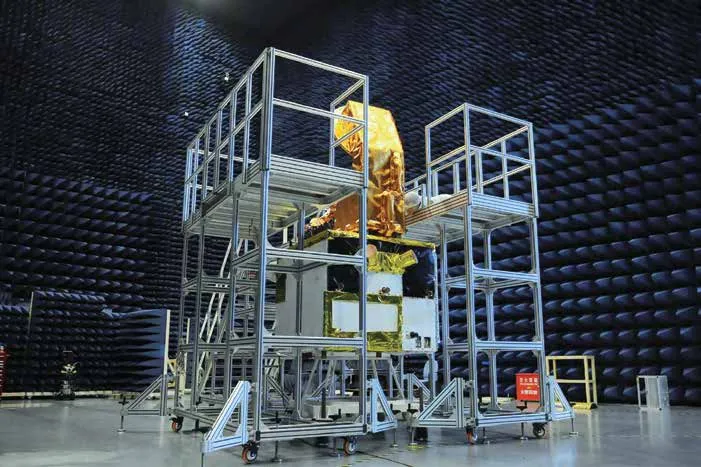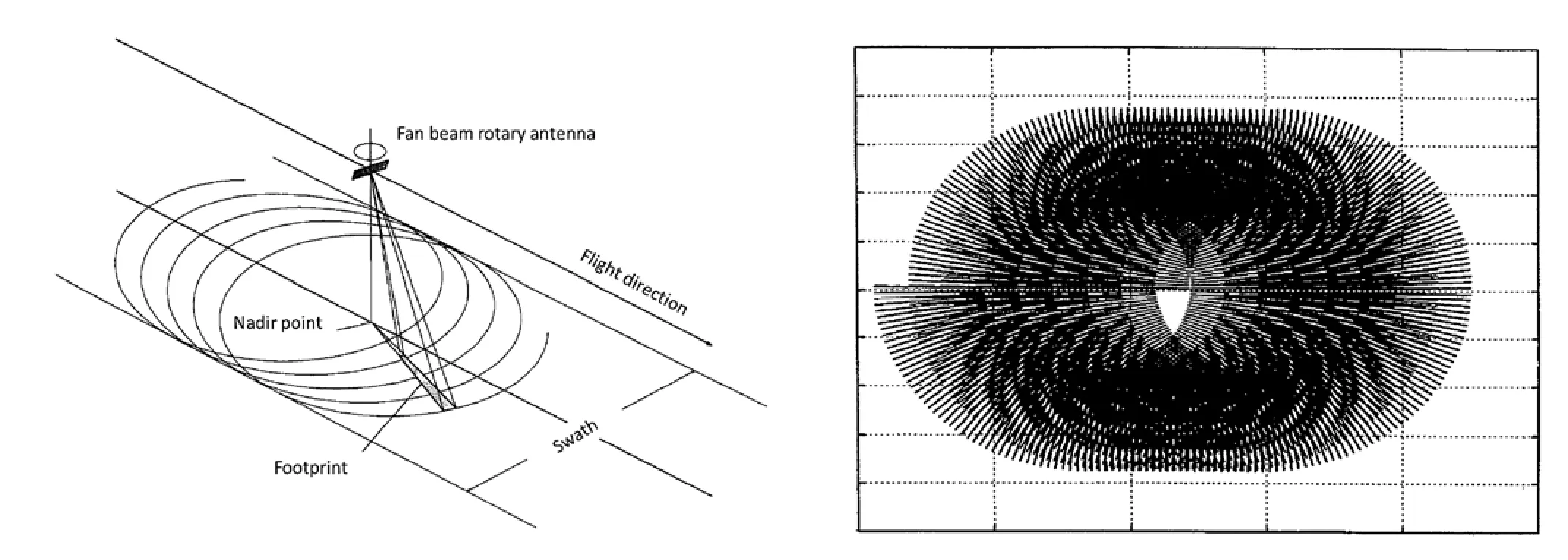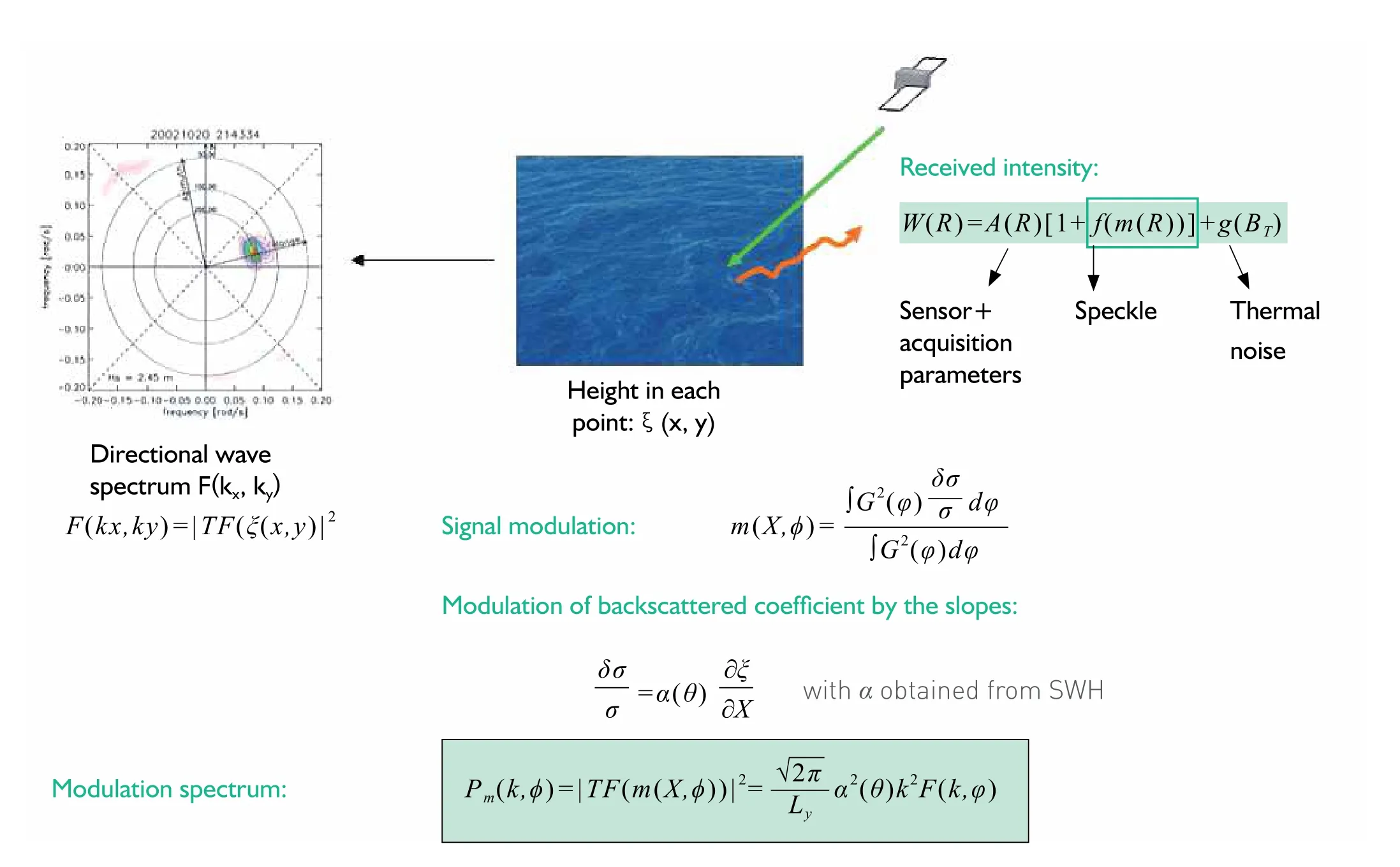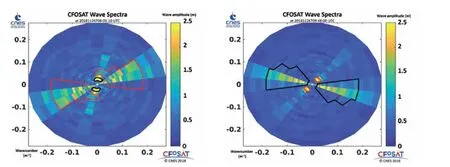CFOSAT-1 Realizes First Joint Observation of Sea Wind and Waves
2019-05-15WANGLiliDINGZhenyuZHANGLeiYANCheng
WANG Lili, DING Zhenyu, ZHANG Lei, YAN Cheng
DFH Satellite Co., Ltd., Beijing 100080
Abstract: The Chinese-French Oceanic Satellite 1 (CFOSAT-1) was successfully launched on October 29, 2018.The satellite was developed under cooperation between China and France. CFOSAT-1 realizes joint observation of sea waves and wind for the first time in the world. This paper introduces the background of the satellite, including application goals and the division of the project. The paper describes the satellite platform composition, the coverage and benefit of conducting joint observation as well as the working principle, structure and performance of the two payloads,SCAT and SWIM, and introduces the in-orbit observation results of sea wind and waves. The difficulties during the development, solutions and acquired experience for future international space cooperation are also introduced. Finally,the conclusion concerning CFOSAT-1's contributions to sea state forecast, marine and climate research, as well as its important role in the ocean dynamic environment detection system.
Key words: CFOSAT-1, wind, waves, ocean dynamics, SCAT, SWIM
1 INTRODUCTION
On October 29, 2018, the Chinese-French Oceanic Satellite 1 (CFOSAT-1) was successfully launched into its orbit from the Jiuquan Satellite Launch Center and it is working normally.As an international cooperation mission for space-borne ground observation between China and France, CFOSAT-1 represents the successful conclusion of joint research and development in satellite engineering at a system level for two advanced aerospace agencies in the world. CFOSAT-1 was mainly developed by the DFH Satellite Co., Ltd. (DFHSat) and used for ocean dynamics observation.
As an important part of ocean dynamics, sea wind and waves are closely related with marine navigation and production activities. “No wind, no waves”, there is a complicated boundary coupling process at the sea surface between waves and the atmosphere. Therefore, the relationship between sea wind and waves has long attracted the interest of scientists. CFOSAT-1 is the first satellite in the world that measures simultaneously the sea wave spectrum and sea surface wind field. It will greatly improve the knowledge of interaction between sea wind and waves, as well as the research on ocean dynamics.
This paper introduces the satellite mission, the system composition, the working principle of the payloads, and the in-orbit observation result.
2 MISSION OF CFOSAT-1
By the joint observation of its payloads, CFOSAT-1 acquires simultaneously sea surface waves and wind field data. By as-similating the data into a sea wave forecast model, it improves the accuracy of the model. It can also improve the atmospheric forecast model and the understanding of the relationship between sea wind and waves. The main application goals of CFOSAT-1 are as follows:
1) Acquire the basic parameters of ocean dynamics such as sea wave spectrum, significant wave height and sea surface wind field on a global scale.
2) Provide multi-parameter initial field information for marine forecast such as sea wave spectrum and the surface wind field to improve the forecasting and assimilating model, and improve the accuracy and timeliness of forecast for catastrophic sea-state conditions such as those for “giant waves”, ocean tropical storms and storm surges.
3) Realize large-scale synchronous monitoring of important ocean parameters, to improve the marine science research on wind-wave generation mechanism and evolution process, and air-sea flux exchange. Accumulate long-time series historical data for the research on global climate change.
4) Strengthen the three-dimensional observation method in global marine monitoring, develop new fields and make up for the shortage of current in-orbit satellites in terms of detection means, time and space.
The project was divided as follows. DFH provided the satellite platform and was responsible for the system development.The French National Space Agency (CNES) provided the payload for Surface Waves Investigation and Monitoring (SWIM)and the radio frequency part of the data transmission subsystem(DTS). While the National Space Science Center (NSSC) provided the Chinese payload scatterometer (SCAT). The launch vehicle, launch activity, satellite monitoring and control were and are on Chinese side. China and France share ground receiving stations in Canada, Sweden and China. The scientific data is shared by both sides.
3 SATELLITE PLATFORM
CFOSAT-1 is a three-axis stabilized microwave ground observation satellite. The satellite uses the CAST2000 series platform, weighs about 660 kg, runs in a sun-synchronous orbit at an average height of 521 km, and has a 3-year design life.Payloads include SCAT, SWIM and DTS. Since the antennas of both SCAT and SWIM keep rotating in normal working mode,the rotation will generate interference in the satellite attitude. To avoid this interference, the satellite adopts a “zero momentum”control wheel solution, and uses a star sensor to obtain accurate attitude data to meet the payloads' requirement for precise attitude measurement. In order to calibrate and test in orbit the pointing angle of the SWIM antenna's electric axis, the satellite is capable of long-term flight, in a biased attitude mode, while still meeting the requirement for attitude and orbit control. In addition, the satellite has the ability for double-pulse orbit transfer.This means ground personnel can upload two groups of orbit control parameters in one satellite transit, and the satellite can accomplish independently two discrete orbit transfers outside of the ground controlled area. This ability increases the efficiency of orbit transfer.
4 FEATURES OF CFOSAT-1
4.1 First Joint Observation of Sea Winds and Waves
CFOSAT-1 is the first satellite that realizes joint observation of sea wind and waves in the world with its 24-hour working SCAT and SWIM payloads. It can acquire synchronously the observation data of global sea surface wind and wave spectrum.SCAT achieves 96.55% coverage of the Earth surface in 3 days and 99.92% in 13 days. SWIM covers 49.16% of the Earth in 3 days and 99.20% in 13 days. The satellite covers almost all the earth surface and realizes monitoring on most ice regions at the two poles.
SWIM works in small incidence angles from 0 to 10 degrees. SCAT works in large incidence angles, typically from 26 to 46 degrees. This multi-incidence-angle design enables the satellite to obtain multi-scale sea surface wind field and wave information from minor waves (several centimeters), medium waves (ten centimeters to several meters) to long waves (longer than ten more meters), and provides opportunities for the research of the temporal and spatial variation of waves and the propagation process under different scales. Joint observation can also improve the temporal and spatial distribution of the sea wind field data and its accuracy, provide diversified significant wave height data, enrich the assimilation data of the sea wave model, and help improve the sea wave assimilation effect.
Besides its great benefit, joint observation of sea wind and waves required a higher standard on the development and construction of the satellite. The two payloads work simulta-neously in Ku band, with an interval of 160 MHz. Since, these two high-power microwave emitting instruments have to work in such close frequencies at the same time within the limited space of the satellite, it is highly possible that interference occurs where signals from one instrument enter the other receiving channel and are treated as its own signals- and affect the other instrument's normal work. Therefore, the avoidance of the interference between transmitted signals from the two payloads becomes an important part of satellite and payload electromagnetic compatibility (EMC) design. Accurate measurement of the interference signals is also crucial to the satellite EMC test.Therefore, the CFOSAT-1 team designed a radio frequency filter isolation scheme, and proposed a suppression method for the wall-reflected signals based on temporal wave gate control.This method helps to improve the measurement accuracy not only of the antenna isolation between the two payloads but for the interference signals. Figure 1 shows the setup in the EMC test.
4.2 Features of SCAT
SCAT is the Chinese payload, developed by NSSC. It is the first spaceborne fan-shaped beam rotary scanning scatterometer in the world. The blowing of the sea wind will induce capillary waves on the ocean surface. This wind—induced capillary wave amplitude grows bigger as the wind speed increases, and its texture direction varies with the wind direction. SCAT measures the centimeter-long microwave's Bragg scattering on the wind—induced capillary wave (the scattering amplitude is related with wind speed and direction), acquires sea surface scattering information related with the amplitude and texture direction of the wind—induced capillary wave, and obtains the sea surface wind speed and direction information by data processing.
SCAT works in Ku band and has a bandwidth of 0.5 MHz.It is mainly comprised 13 parts: power distribution unit, digital processing unit, two transmitting and receiving units, two radio frequency receiving units, two travelling wave tubes, two electronic power conditioners, microwave front end, servo control unit, antenna and scanning mechanism. The antenna has two arrays, one for horizontal polarization and the other for vertical polarization.

Figure 1 CFOSAT-1 EMC test setup
The working principle of SCAT is as follows. The signal generator in the digital processing unit produces a pulse signal.The transmitting and receiving unit converts the pulse signal up to radio frequency. The up-converted signal is amplified in transmitting power up to 120 W by the travelling wave tube amplifier (TWTA), is transferred to the microwave front end and finally radiates into space through the antenna. The radiated signal is reflected by the sea surface, and the echo is received by the antenna, passing through the microwave front end, amplified by the radio frequency receiving unit, and then sampled and pre-processed by the digital processing unit. Since the echo power is proportional to the sea surface back scattering coefficient, SCAT uses its microwave front end to couple part of the transmitted signal power into the receiver for internal calibration processing, which in turn converts the echo power to back scattering coefficient. By processing multi-group measurement data of the back scattering coefficient acquired for different azimuth and incidence angles within the same ground resolution unit,we can determine the sea surface wind speed and direction inversion result.
The innovation of SCAT lies in the fan-shaped beam rotary scanning system. The antenna rotates at a speed of 3.4 rpm.More specifically, by defining the pitch direction as the wide beam direction and the azimuth direction as the narrow beam direction, the ground resolution unit is realized by different means in these two directions.
In the wide beam direction, the ground resolution is realized by the range measurement. The ground projection of the length in each slant range gate (slant range resolution) is the ground resolution. In order to have more independent samples,the real range resolution of SCAT is much higher than what the ground resolution requires. The real range resolution is lowered in the incoherent averaging of the ground sub-resolution unit, so as to improve the measurement precision.
In the narrow beam direction the ground resolution is realized by the beam limit. In this direction, the ground resolution corresponds to the footprint of the fan-shaped beam in azimuth.Since the SCAT antenna beam keeps scanning the ground, the angle that the beam sweeps among each two pulses is smaller than the beam width. By using incoherent inter-pulse averaging in this direction, we can further improve the measurement precision.
The rotary fan-shaped beam antenna creates a fan-shaped footprint. The rotation of the footprint creates an observation swath on the ground whose width is determined by the incidence of the outer edge of the beam. The movement of the satellite realizes the continuous observation of land and sea.During the satellite movement and the antenna rotation, according to different positions in the cross-orbit direction within the observation swath, the scanning of the antenna can realize more than 2 discrete observations at different incidence angles(both pitch and azimuth direction) of the same ground resolution unit within a short time interval. With this measurement data of back scattering coefficient, we can achieve the inversion of the sea surface wind speed and direction. The observation geometry and the ground coverage are shown in Figure 2.
The working modes of SCAT include back scattering measurement mode and test calibration mode. The former one is the main mode and includes two operations: sea surface echo measurement and periodic internal calibration. In the sea surface echo measurement, SCAT works alternatively in two polarization modes, HH and VV, and renders a range distribution of the back scattering coefficient at a resolution about 4 km.When the antenna rotates to a position perpendicular to the flight direction, SCAT performs internal calibration, in order to eliminate the influence on measurement from the fluctuation of the receiver gain and of the transmitted power. The internal calibration includes signal internal calibration and noise internal calibration. The former one is to measure the transmitted power coupled from the microwave front end. The latter one is to measure the noise when there is no signal output from the transmitter. The test calibration mode is used in the development and test phase and used for failure diagnosis. In this mode,SCAT performs original signal sampling and calibration signal monitoring at a relatively low pulse repetition frequency, in such a way as to evaluate the system performance and to determine the fault pattern of the signal channel.
SCAT can provide global sea surface wind field real time measurement data of a 1000 km swath at 12.5 × 12.5 km2ground resolution. The wind speed accuracy is better than 2 m/s or 10% (whichever is the better one), and the wind direction accuracy is better than 20°. Apart from the sea surface wind,SCAT can also provide a near (12.5 km off) shore wind field product. Compared with the traditional pen-shaped beam scatterometer, SCAT has advantages as follows.

Figure 2 Observation geometry (left) and ground coverage (right) of SCAT
1) Acquires multi-angle sea surface back scattering information at the same time. Provides unprecedented observation ability for the research of sea surface wind stress and the interaction between sea and atmosphere.
2) Realizes continuous observation of the back scattering coefficient both in pitch and azimuth direction at the same time. In this way, SCAT shortens the duration of multi-azimuth combined observation of the same sea area, helps to realize high coherence data measurement, improves the accuracy of wind field inversion,and reduces processing complexity.
3) Fan-shaped beam scatterometer has larger single footprint and provides more independent samples of back scattering coefficient than the pen-shaped one. For this reason, SCAT can work at a relatively low speed of antenna rotation. This lowers the impact on the satellite attitude from the antenna rotation, reduces the reliance on the attitude and orbit control instruments such as momentum wheels, helps to realize the miniaturization of both the payload and the platform, and reduces the cost of satellite construction, development and launch.
4) The low speed of the antenna rotation is also helpful to obtain greater redundancy for the back scattering coefficient data in azimuth. Greater redundancy can further improve the spatial resolution of the measured unit by the resolution enhancement technique. Combined with successive observation footprint in the pitch direction,the fan-shaped beam scatterometer has an advantage for sea and polar ice monitoring, near shore wind field measurement and land applications.
4.3 Features of SWIM
SWIM is the French payload developed by CNES. SWIM is the first spaceborne instrument in the world that measures the sea wave spectrum. Compared with the wind—induced and relatively small scale capillary waves, large scale waves will tilt at the sea surface. This tilt introduces modulation into the sea surface back scattering coefficient, and a Fourier spectrum of the modulation is related with the directional wave spectrum, which includes sea wave propagation direction and wave length information (Figure 3). SWIM obtains information of the sea wave modulation on the back scattering coefficient and this is where its innovation lies.
SWIM uses a multi-beam-shared asymmetrically-fed reflector antenna. By transmitting one nadir beam (0°) and five rotary scanning beams at small incidence angles (2°, 4°, 6°, 8° and 10°), SWIM acquires information of specular and quasi-specular scattering at different incidence angles of the sea surface. The nadir beam measures the significant wave height of the sea surface, and the side-looking beams acquire in different azimuth angles the modulation information of waves tilt on back scattering coefficient. Combining the nadir beam and the side-looking beams, we can obtain the sea waves directional spectrum data,and obtain wave length, propagation direction and other ocean dynamics information after further data processing.
SWIM works in Ku band and has a bandwidth of 320 MHz.The antenna is comprised of a circular reflector and a rotary feed assembly. The reflector has a diameter of 90 cm and the rotary feed rotates at a speed of 5.7 rpm. The basic working process of SWIM is as follows. The transmitter radiates a 120W pulse signal into the sea surface through the antenna. The reflected signal is received by the antenna and enters into the receiver, down-converted to a video frequency, and delivered to the digital processing unit for further processing. Meanwhile,the internal calibration instrument couples part of the power of the transmitted signal into the receiver, in order to eliminate the measurement error induced by the fluctuation of the transmitted power and of the channel gain. The signal processing unit performs correlation between echoes of different beams and the internal calibration signals, so as to obtain the sea surface back scattering coefficient. By doing Fourier transformation and self-correlation of the back scattering coefficient, and combining information from different beams, we can have the sea wave directional spectrum data at a given azimuth angle. Furthermore,the rotation of different beams realizes multi-azimuth angle observation, by which we can have two-directional wave direction spectrum.
The working modes of SWIM include the normal mode,calibration mode and test mode. In the normal mode, the six beams at different incidence angles combine under a given rule.Each beam scans and radiates signals in its cycle, respectively and successively. The calibration mode is similar to the internal calibration mode of SCAT, which includes internal calibration and noise calibration. The test mode includes fixed angle mode and speckle estimation mode. In the fixed angle mode, the rotary feed assembly acquires echoes at four fixed angles of 0°,90°, 180° and 270°. The speckle estimation mode reduces the number of pulses in each averaging process, and increases the number of signals of average amplitude within each processing period at a given incidence angle, in a way to better estimate the speckle noise spectrum.
SWIM can provide global sea waves information at wavelengths from 70 m to 500 m and at a resolution of 70 × 70 km2with wavelength accuracy better than 15%, wave direction accuracy better than 15° and significant wave height accuracy better than 0.5 m (when smaller than 5 m) or 10%.

Figure 3 Modulation of sea waves on back scattering coefficient
5 IN-ORBIT OBSERVATION RESULTS
On November 1, after three orbit transfers, SCAT and SWIM began their mission to observe the sea wind and waves.Until December 3, CFOSAT-1 had acquired more than 400 data tracks and provided important information of the sea state.From the observation data, it becomes more intuitive and effective to judge the daily distribution and movement of the westerlies cyclones,as well as the position,intensity and destruction of typhoons. For example, concerning the 28th typhoon “Wanyi”that originated in the north-western Pacific Ocean, CFOSAT-1 captured its morphological character, center position, route and speed,provided reference of analysis, judgment, forecast and decision making for the government. The inversion result of the global sea surface wind field distribution from the five-day long observation data of SCAT is shown in Figure 4. From the figure,we can see the distribution of intense sea winds in the northern Pacific Ocean, the northern Atlantic Ocean and southeast to Australia. The result of the sea wave spectrum from the SWIM data is shown in Figure 5. Further analysis is in progress.

Figure 4 Global sea wind filed distribution from SCAT data, UTC 20181125 to 20181129, NSOAS

Figure 5 Sea wave spectrum from SWIM data, UTC 20181126, CNES
Currently, the in-orbit functional tests of the platform and payloads have been successfully completed, and the performance test of the payloads and the optimization of the observation mission will be conducted in the next phase.
6 DIFFICULTIES AND SOLUTIONS
During the development of CFOSAT-1, the team encountered difficulties from the political side rather than the technical.The design of CFOSAT-1 went smoothly and was finished in June, 2010. However, due to the restriction on exports to China from the ITAR agreement issued by the U.S.A, the French side had to change almost 90% percent of components in their products. As a result, all the design of French products including SWIM and DTS as well as their interface on the satellite platform had to be made again, and the components purchased,assembled and tested again. This process imposed serious influence on the development progress of CFOSAT-1 with a delay of at least 3 years. Apart from the time delay, it also led to another problem with the life and reliability of Chinese products.The satellite was expected to work 3 years in orbit, and some components were designed to meet this life-span plus the necessary time for ground tests. Therefore, with the addition of the unexpected delay of more than 3 years, some components had exceeded or nearly reached their expiration limit. The traditional way would be to purchase new components and undergo the test again, which would bring great financial burden and time cost on the project. To solve this problem, the team adopted some new strategies. First was to optimize the interface between Chinese and French products in a way to expedite the development of French products. Second, was for the life limited problem, where special plans to analyze and test the quality and reliability of those specific components was conducted. If the component failed the test, the team replaced it with a new one. Great effort brings great result. The project thereafter progressed well and the satellite was successfully launched into orbit, and is functioning normally until now.
Despite the difficulties, we have acquired precious experience from this incident. For international cooperation, apart from technical and transportation factors, we should consider the political and diplomatic factors of the countries within the cooperation. We even have to take into account the influence from a third country outside the cooperation, and consider the potential impact of multilateral agreements. As a response, we should make ahead alternative plans for design, purchase, storage and replacement. This experience could serve as guidance for future international space cooperation.
7 CONCLUSIONS
CFOSAT-1 for the first time in the world realizes synchronous observation of sea surface wind field and waves on a global scale. It helps to better understand the ocean dynamic process and pattern of its evolution, improve the quality of sea state forecast and the assimilation model, provide measurement data for the research of marine sciences and global climate change.Besides, the scientific data of CFOSAT-1 supports the research and application of marine geophysics, marine climate and environment monitoring, and sea ice monitoring.
As an important part of the ocean dynamic environment detection system, CFOSAT-1 will work in alliance with HY-2A,HY-2B and other in-orbit satellites, to fulfill the functional complementation, strengthen the detection ability, integrate the detection information of the ocean dynamic environment,improve temporal and spatial resolution of the data, and finally build up an all-day, all-weather, timely and high resolution ocean dynamic environment remote sensing system.
杂志排行
Aerospace China的其它文章
- Application of Genetic Algorithm in Estimation of Gyro Drift Error Model
- Numerical Simulation of Unsteady Flow of Reentry Capsule
- Analysis and Solution of Multipath Effect on Wireless Communications of Launch Vehicle
- Application Advantages of Staring Area Imaging Technology (SAIT) for Microsatellites
- Analysis of China's Nano andMicrosatellite Industry Development
- XUE Huifeng Attended the IAA Spring Meetings
